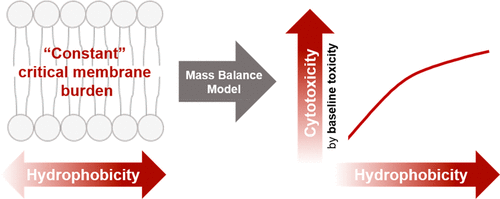当前位置:
X-MOL 学术
›
Chem. Res. Toxicol.
›
论文详情
Our official English website, www.x-mol.net, welcomes your
feedback! (Note: you will need to create a separate account there.)
Critical Membrane Concentration and Mass-Balance Model to Identify Baseline Cytotoxicity of Hydrophobic and Ionizable Organic Chemicals in Mammalian Cell Lines
Chemical Research in Toxicology ( IF 3.7 ) Pub Date : 2021-08-06 , DOI: 10.1021/acs.chemrestox.1c00182 Jungeun Lee 1 , Georg Braun 1 , Luise Henneberger 1 , Maria König 1 , Rita Schlichting 1 , Stefan Scholz 2 , Beate I Escher 1, 3
Chemical Research in Toxicology ( IF 3.7 ) Pub Date : 2021-08-06 , DOI: 10.1021/acs.chemrestox.1c00182 Jungeun Lee 1 , Georg Braun 1 , Luise Henneberger 1 , Maria König 1 , Rita Schlichting 1 , Stefan Scholz 2 , Beate I Escher 1, 3
Affiliation

|
All chemicals can interfere with cellular membranes and this leads to baseline toxicity, which is the minimal toxicity any chemical elicits. The critical membrane burden is constant for all chemicals; that is, the dosing concentrations to trigger baseline toxicity decrease with increasing hydrophobicity of the chemicals. Quantitative structure–activity relationships, based on hydrophobicity of chemicals, have been established to predict nominal concentrations causing baseline toxicity in human and mammalian cell lines. However, their applicability is limited to hydrophilic neutral compounds. To develop a prediction model that includes more hydrophobic and charged organic chemicals, a mass balance model was applied for mammalian cells (AREc32, AhR-CALUX, PPARγ-BLA, and SH-SY5Y) considering different bioassay conditions. The critical membrane burden for baseline toxicity was converted into nominal concentration causing 10% cytotoxicity by baseline toxicity (IC10,baseline) using a mass balance model whose main chemical input parameter was the liposome-water partition constants (Klip/w) for neutral chemicals or the speciation-corrected Dlip/w(pH 7.4) for ionizable chemicals plus the bioassay-specific protein, lipid, and water contents of cells and media. In these bioassay-specific models, log(1/IC10,baseline) increased with increasing hydrophobicity, and the relationship started to level off at log Dlip/w around 2. The bioassay-specific models were applied to 392 chemicals covering a broad range of hydrophobicity and speciation. Comparing the predicted IC10,baseline and experimental cytotoxicity IC10, known baseline toxicants and many additional chemicals were identified as baseline toxicants, while the others were classified based on specificity of their modes of action in the four cell lines, confirming excess toxicity of some fungicides, antibiotics, and uncouplers. Given the similarity of the bioassay-specific models, we propose a generalized baseline-model for adherent human cell lines: log[1/IC10,baseline (M)] = 1.23 + 4.97 × (1 – e–0.236 log Dlip/w). The derived models for baseline toxicity may serve for specificity analysis in reporter gene and neurotoxicity assays as well as for planning the dosing for cell-based assays.
中文翻译:

临界膜浓度和质量平衡模型,以确定哺乳动物细胞系中疏水性和可电离有机化学物质的基线细胞毒性
所有化学品都会干扰细胞膜,这会导致基线毒性,这是任何化学品引起的最小毒性。所有化学品的临界膜负荷是恒定的;也就是说,触发基线毒性的剂量浓度随着化学品疏水性的增加而降低。已经建立了基于化学品疏水性的定量结构-活性关系,以预测在人类和哺乳动物细胞系中引起基线毒性的标称浓度。然而,它们的适用性仅限于亲水性中性化合物。为了开发包含更多疏水性和带电有机化学物质的预测模型,考虑到不同的生物测定条件,对哺乳动物细胞(AREc32、AhR-CALUX、PPARγ-BLA 和 SH-SY5Y)应用了质量平衡模型。10,基线)使用质量平衡模型,其主要化学输入参数是中性化学物质的脂质体 - 水分配常数(K lip / w)或可电离化学物质的形态校正D lip / w(pH 7.4)加上生物测定 -细胞和培养基的特定蛋白质、脂质和水含量。在这些生物测定特定模型中,log(1/IC 10,baseline ) 随着疏水性的增加而增加,并且这种关系在 log D lip/w约为 2 时开始趋于平稳。生物测定特定模型应用于 392 种化学品,涵盖广泛疏水性和物种形成的范围。比较预测的 IC 10、基线和实验细胞毒性 IC 10、已知的基线毒物和许多其他化学物质被确定为基线毒物,而其他化学品则根据它们在四种细胞系中的作用方式的特异性进行分类,证实了一些杀菌剂、抗生素和解偶联剂的过度毒性。鉴于生物测定特定模型的相似性,我们提出了一个适用于粘附人细胞系的通用基线模型:log[1/IC 10,baseline (M)] = 1.23 + 4.97 × (1 – e –0.236 log D lip/ w )。基线毒性的衍生模型可用于报告基因和神经毒性测定的特异性分析,以及规划基于细胞的测定的剂量。
更新日期:2021-09-20
中文翻译:

临界膜浓度和质量平衡模型,以确定哺乳动物细胞系中疏水性和可电离有机化学物质的基线细胞毒性
所有化学品都会干扰细胞膜,这会导致基线毒性,这是任何化学品引起的最小毒性。所有化学品的临界膜负荷是恒定的;也就是说,触发基线毒性的剂量浓度随着化学品疏水性的增加而降低。已经建立了基于化学品疏水性的定量结构-活性关系,以预测在人类和哺乳动物细胞系中引起基线毒性的标称浓度。然而,它们的适用性仅限于亲水性中性化合物。为了开发包含更多疏水性和带电有机化学物质的预测模型,考虑到不同的生物测定条件,对哺乳动物细胞(AREc32、AhR-CALUX、PPARγ-BLA 和 SH-SY5Y)应用了质量平衡模型。10,基线)使用质量平衡模型,其主要化学输入参数是中性化学物质的脂质体 - 水分配常数(K lip / w)或可电离化学物质的形态校正D lip / w(pH 7.4)加上生物测定 -细胞和培养基的特定蛋白质、脂质和水含量。在这些生物测定特定模型中,log(1/IC 10,baseline ) 随着疏水性的增加而增加,并且这种关系在 log D lip/w约为 2 时开始趋于平稳。生物测定特定模型应用于 392 种化学品,涵盖广泛疏水性和物种形成的范围。比较预测的 IC 10、基线和实验细胞毒性 IC 10、已知的基线毒物和许多其他化学物质被确定为基线毒物,而其他化学品则根据它们在四种细胞系中的作用方式的特异性进行分类,证实了一些杀菌剂、抗生素和解偶联剂的过度毒性。鉴于生物测定特定模型的相似性,我们提出了一个适用于粘附人细胞系的通用基线模型:log[1/IC 10,baseline (M)] = 1.23 + 4.97 × (1 – e –0.236 log D lip/ w )。基线毒性的衍生模型可用于报告基因和神经毒性测定的特异性分析,以及规划基于细胞的测定的剂量。











































 京公网安备 11010802027423号
京公网安备 11010802027423号